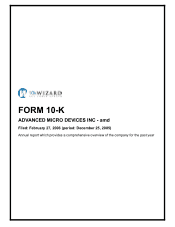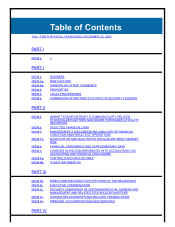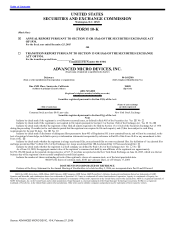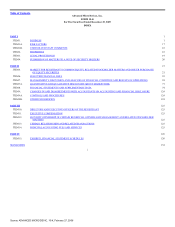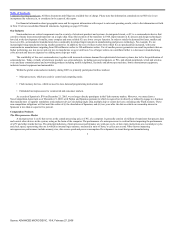AMD 2005 Annual Report Download - page 10
Download and view the complete annual report
Please find page 10 of the 2005 AMD annual report below. You can navigate through the pages in the report by either clicking on the pages listed below, or by using the keyword search tool below to find specific information within the annual report.
Table of Contents
processors can also deliver performance improvements for “multithreaded” software applications by processing different parts of the software programs, or
“threads,” simultaneously on two cores, thereby maximizing the performance of the application. We design the AMD Athlon 64 X2 dual-core processors for
“prosumer” and digital media enthusiasts or other users who routinely run multiple processor-intensive software applications simultaneously. We expect sales of
our AMD Athlon 64 X2 dual-core processors to increase as software applications designed to take advantage of the performance features of dual-core processors
become increasingly available.
Mobile PCs. Our microprocessors for the mobile computing market consist of mobile AMD Athlon 64 processors and mobile AMD Sempron
processors. We designed our mobile processor products for high-performance computing and wireless connectivity. They feature advanced power management
from AMD PowerNow!™ technology, which offers reduced power consumption and extended system battery life.
In March 2005, we introduced AMD Turion ™ 64 mobile technology. Processors incorporating this technology represent our most advanced family of 32-
and 64-bit Windows-compatible processors for notebook PCs, and provide performance improvements such as longer battery life, reduced heat generation,
enhanced security and compatibility with current wireless and graphics solutions. We expect to introduce dual-core processors based on AMD Turion 64 mobile
technology in mid-2006.
Servers and Workstations. Our x86 microprocessors for servers and workstations consist primarily of AMD Opteron ™ processors. A server is a powerful
computer on a network, often with multiple microprocessors working together, that is dedicated to a particular purpose, stores large amounts of information and
performs the critical functions for that purpose. A workstation is essentially a heavy-duty desktop, designed for tasks such as computer-aided design and digital
content creation. We based our AMD Opteron processors for servers and workstations on the AMD64 technology and designed them to allow simultaneous
32-bit and 64-bit computing. These processors can be used in a variety of server applications, including business processing (enterprise resource planning,
customer relationship management, and supply chain management) and business intelligence. They can also be used in workstation applications such as
engineering and digital content creation software and other information technology infrastructure applications such as intensive Web serving and messaging.
We also offer AMD Opteron processors for high-end embedded designs that require low-power and high-performance. For these designs, our low-power
AMD Opteron processors deliver the same performance as their corresponding full-power parts, while offering the added benefit of reduced power consumption
and thermal output. The target markets for these processors include standard servers and blade servers where lower power is needed to enable dense designs and
in embedded controllers like those found in networking, mass storage and telecommunications. A blade server is typically used for a single, dedicated application
(such as serving Web pages) and can be inserted into a space-saving rack with many other similar servers.
In April 2005, we introduced our dual-core AMD Opteron processors. Like our AMD Athlon 64 X2 dual-core processors, our dual-core AMD Opteron
processors offer improved overall performance such as improved multithreading and multitasking, and improved performance-per-watt, which can reduce the
operational costs related to power usage.
Our AMD Opteron, AMD Athlon 64, AMD Turion 64 and certain AMD Sempron processors are based on AMD64 technology with direct connect
architecture. Direct connect architecture connects an on-chip memory controller and I/O, or input/output, channels directly to one or more microprocessors cores.
For dual-core processors, each core has its own dedicated cache, which is memory that is located on the semiconductor die. We believe this architecture, and in
particular the integrated memory controller, enables substantially higher performance because memory can be accessed more directly rather than traversing a
traditional front-side bus, which results in increased bandwidth and reduced memory latencies. We also designed the AMD64 architecture to enhance the security
of a user’s computing environment by integrating security features that are designed to prevent the spread of certain viruses when enabled by the anti-virus
features of current versions of certain
5
Source: ADVANCED MICRO DEVIC, 10-K, February 27, 2006

